「Python入门只需30分钟」从安装到数据抓取、存储原来这么简单!
Pyth

Python (编程语言) 沿着一条乡村公路路标
on 的安装 到开发工具的简单介绍,并编写一个抓取天气信息数据并存储到数据库的例子。(这篇文章适用于完全不了解Python的小白超超超快速入门)
关注,转发,私信“资料”可以获取Python学习入门资料+安装教程+环境搭建哦!
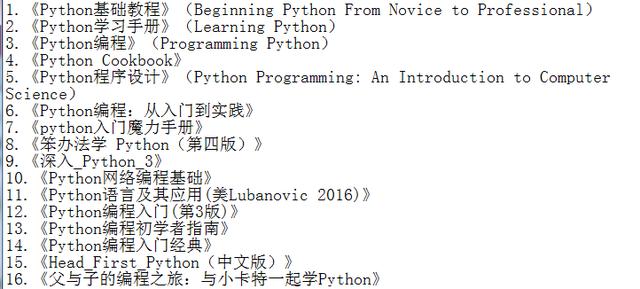
如果有时间的话,强烈建议跟着一起操作一遍,因为介绍的真的很详细了。
- Python 安装
- PyCharm(ide) 安装
- 抓取天气信息
- 数据写入excel
- 数据写入数据库
Python 安装
下载 Python: 官网地址: https://www.python.org/
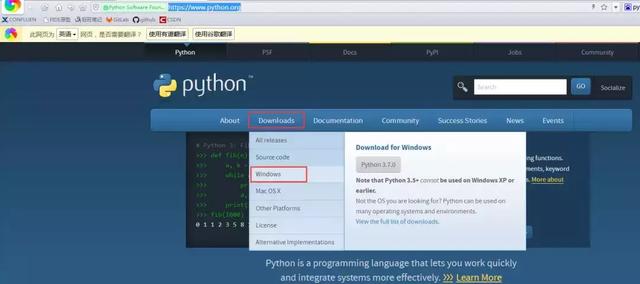
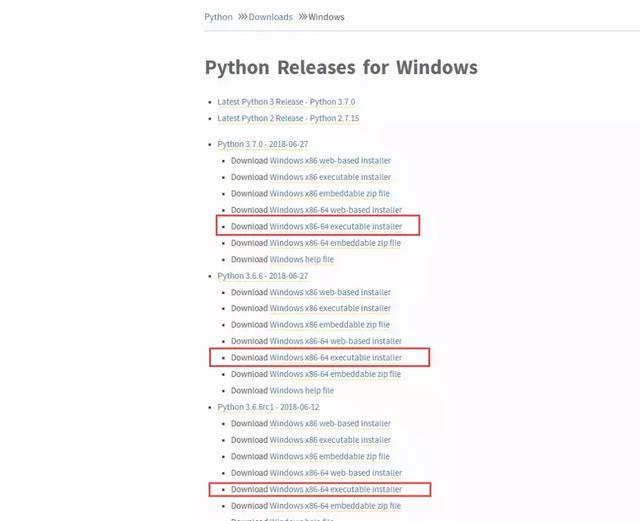
选择你希望下载的版本(都可以的),还有是否64位,选择下载的文件类型时,推荐下载安装包,因为在安装的时候回自动给你配环境路径。(在下载的时候你可以去下载 python 的 开发工具 PyCharm,获取去简单了解一下 Python)
安装时需要注意的是:勾选 Add Python x.x to Path
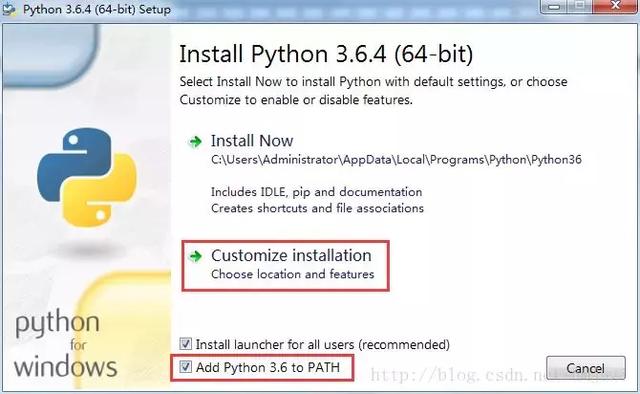
安装好之后,打开cmd,输入python,如果出现提示,则完成。

PyCharm 安装
下载 PyCharm : 官网地址:http://www.jetbrains.com/pycharm/


免费版本的可以会有部分功能缺失,所以不推荐,所以这里我们选择下载企业版。
安装好 PyCharm,首次打开可能需要你 输入邮箱 或者 输入激活码,获取激活码
对于 PyCharm 的基本使用,可以简单看一下 这篇博客
抓取天气信息
Python 的基础语法推荐在网上看些教程:菜鸟教程
Python的详细学习还是需要些时间的。如果有其他语言经验的,可以暂时跟着我来写一个简单的例子。
我们计划抓取的数据:杭州的天气信息,杭州天气 可以先看一下这个网站。
实现数据抓取的逻辑:使用python 请求 URL,会返回对应的 HTML 信息,我们解析 html,获得自己需要的数据。(很简单的逻辑)
第一步:创建 Python 文件

写第一段Python代码
if __name__ == '__main__': url = 'http://www.weather.com.cn/weather/101210101.shtml' print('my frist python file')这段代码类似于 Java 中的 Main 方法。可以直接鼠标右键,选择 Run。
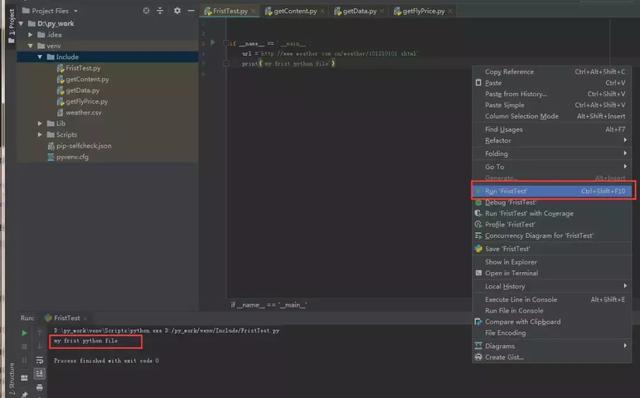
第二步:请求RUL
python 的强大之处就在于它有大量的模块(类似于Java 的 jar 包)可以直接拿来使用。
我们需要安装一个 request 模块: File - Setting - Product - Product Interpreter

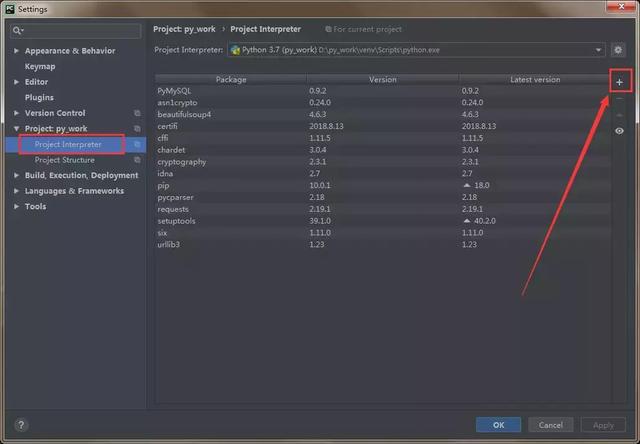
点击如上图的 + 号,就可以安装 Python 模块了。搜索 requests 模块(有 s 噢),点击 Install。
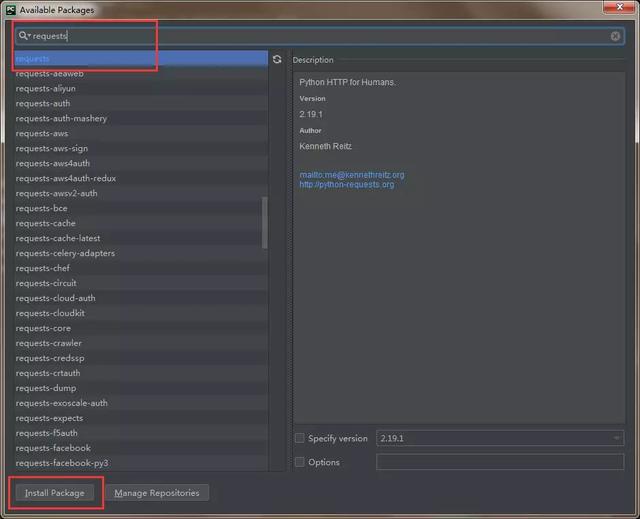
我们顺便再安装一个 beautifulSoup4 和 pymysql 模块,beautifulSoup4 模块是用来解析 html 的,可以对象化 HTML 字符串。pymysql 模块是用来连接 mysql 数据库使用的。


相关的模块都安装之后,就可以开心的敲代码了。
定义一个 getContent 方法:
# 导入相关联的包import requestsimport timeimport randomimport socketimport http.clientimport pymysqlfrom bs4 import BeautifulSoupdef getContent(url , data = None): header={ 'Accept': 'text/html,application/xhtml+xml,application/xml;q=0.9,image/webp,*/*;q=0.8', 'Accept-Encoding': 'gzip, deflate, sdch', 'Accept-Language': 'zh-CN,zh;q=0.8', 'Connection': 'keep-alive', 'User-Agent': 'Mozilla/5.0 (Windows NT 6.3; WOW64) AppleWebKit/537.36 (KHTML, like Gecko) Chrome/43.0.235' } # request 的请求头 timeout = random.choice(range(80, 180)) while True: try: rep = requests.get(url,headers = header,timeout = timeout) #请求url地址,获得返回 response 信息 rep.encoding = 'utf-8' break except socket.timeout as e: # 以下都是异常处理 print( '3:', e) time.sleep(random.choice(range(8,15))) except socket.error as e: print( '4:', e) time.sleep(random.choice(range(20, 60))) except http.client.BadStatusLine as e: print( '5:', e) time.sleep(random.choice(range(30, 80))) except http.client.IncompleteRead as e: print( '6:', e) time.sleep(random.choice(range(5, 15))) print('request success') return rep.text # 返回的 Html 全文在 main 方法中调用:
if __name__ == '__main__': url ='http://www.weather.com.cn/weather/101210101.shtml' html = getContent(url) # 调用获取网页信息 print('my frist python file')第三步:分析页面数据
定义一个 getData 方法:
def getData(html_text): final = [] bs = BeautifulSoup(html_text, "html.parser") # 创建BeautifulSoup对象 body = bs.body #获取body data = body.find('div',{'id': '7d'}) ul = data.find('ul') li = ul.find_all('li') for day in li: temp = [] date = day.find('h1').string temp.append(date) #添加日期 inf = day.find_all('p') weather = inf[0].string #天气 temp.append(weather) temperature_highest = inf[1].find('span').string #最高温度 temperature_low = inf[1].find('i').string # 最低温度 temp.append(temperature_low) temp.append(temperature_highest) final.append(temp) print('getDate success') return final上面的解析其实就是按照 HTML 的规则解析的。可以打开 杭州天气 在开发者模式中(F12),看一下页面的元素分布。
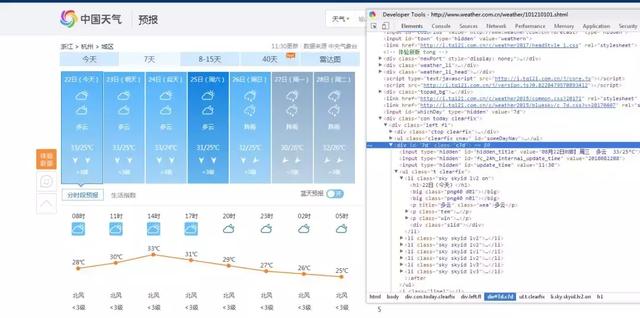
在 main 方法中调用:
if __name__ == '__main__': url ='http://www.weather.com.cn/weather/101210101.shtml' html = getContent(url) # 获取网页信息 result = getData(html) # 解析网页信息,拿到需要的数据 print('my frist python file')数据写入excel
现在我们已经在 Python 中拿到了想要的数据,对于这些数据我们可以先存放起来,比如把数据写入 csv 中。
定义一个 writeDate 方法:
import csv #导入包def writeData(data, name): with open(name, 'a', errors='ignore', newline='') as f: f_csv = csv.writer(f) f_csv.writerows(data) print('write_csv success')在 main 方法中调用:
if __name__ == '__main__': url ='http://www.weather.com.cn/weather/101210101.shtml' html = getContent(url) # 获取网页信息 result = getData(html) # 解析网页信息,拿到需要的数据 writeData(result, 'D:/py_work/venv/Include/weather.csv') #数据写入到 csv文档中 print('my frist python file')执行之后呢,再指定路径下就会多出一个 weather.csv 文件,可以打开看一下内容。


到这里最简单的数据抓取--储存就完成了。
数据写入数据库
因为一般情况下都会把数据存储在数据库中,所以我们以 mysql 数据库为例,尝试着把数据写入到我们的数据库中。
第一步创建WEATHER 表:
创建表可以在直接在 mysql 客户端进行操作,也可能用 python 创建表。在这里 我们使用 python 来创建一张WEATHER 表。
定义一个 createTable 方法:(之前已经导入了 import pymysql 如果没有的话需要导入包)
def createTable(): # 打开数据库连接 db = pymysql.connect("localhost", "zww", "960128", "test") # 使用 cursor() 方法创建一个游标对象 cursor cursor = db.cursor() # 使用 execute() 方法执行 SQL 查询 cursor.execute("SELECT VERSION()") # 使用 fetchone() 方法获取单条数据. data = cursor.fetchone() print("Database version : %s " % data) # 显示数据库版本(可忽略,作为个栗子) # 使用 execute() 方法执行 SQL,如果表存在则删除 cursor.execute("DROP TABLE IF EXISTS WEATHER") # 使用预处理语句创建表 sql = """CREATE TABLE WEATHER ( w_id int(8) not null primary key auto_increment, w_date varchar(20) NOT NULL , w_detail varchar(30), w_temperature_low varchar(10), w_temperature_high varchar(10)) DEFAULT CHARSET=utf8""" # 这里需要注意设置编码格式,不然中文数据无法插入 cursor.execute(sql) # 关闭数据库连接 db.close() print('create table success')在 main 方法中调用:
if __name__ == '__main__': url ='http://www.weather.com.cn/weather/101210101.shtml' html = getContent(url) # 获取网页信息 result = getData(html) # 解析网页信息,拿到需要的数据 writeData(result, 'D:/py_work/venv/Include/weather.csv') #数据写入到 csv文档中 createTable() #表创建一次就好了,注意 print('my frist python file')执行之后去检查一下数据库,看一下 weather 表是否创建成功了。

第二步批量写入数据至 WEATHER 表:
定义一个 insertData 方法:
def insert_data(datas): # 打开数据库连接 db = pymysql.connect("localhost", "zww", "960128", "test") # 使用 cursor() 方法创建一个游标对象 cursor cursor = db.cursor() try: # 批量插入数据 cursor.executemany('insert into WEATHER(w_id, w_date, w_detail, w_temperature_low, w_temperature_high) value(null, %s,%s,%s,%s)', datas) # sql = "INSERT INTO WEATHER(w_id, # w_date, w_detail, w_temperature) # VALUES (null, '%s','%s','%s')" % # (data[0], data[1], data[2]) # cursor.execute(sql) #单条数据写入 # 提交到数据库执行 db.commit() except Exception as e: print('插入时发生异常' + e) # 如果发生错误则回滚 db.rollback() # 关闭数据库连接 db.close()在 main 方法中调用:
if __name__ == '__main__': url ='http://www.weather.com.cn/weather/101210101.shtml' html = getContent(url) # 获取网页信息 result = getData(html) # 解析网页信息,拿到需要的数据 writeData(result, 'D:/py_work/venv/Include/weather.csv') #数据写入到 csv文档中 # createTable() #表创建一次就好了,注意 insertData(result) #批量写入数据 print('my frist python file')检查:执行这段 Python 语句后,看一下数据库是否有写入数据。有的话就大功告成了。

全部代码看这里:
# 导入相关联的包import requestsimport timeimport randomimport socketimport http.clientimport pymysqlfrom bs4 import BeautifulSoupimport csvdef getContent(url , data = None): header={ 'Accept': 'text/html,application/xhtml+xml,application/xml;q=0.9,image/webp,*/*;q=0.8', 'Accept-Encoding': 'gzip, deflate, sdch', 'Accept-Language': 'zh-CN,zh;q=0.8', 'Connection': 'keep-alive', 'User-Agent': 'Mozilla/5.0 (Windows NT 6.3; WOW64) AppleWebKit/537.36 (KHTML, like Gecko) Chrome/43.0.235' } # request 的请求头 timeout = random.choice(range(80, 180)) while True: try: rep = requests.get(url,headers = header,timeout = timeout) #请求url地址,获得返回 response 信息 rep.encoding = 'utf-8' break except socket.timeout as e: # 以下都是异常处理 print( '3:', e) time.sleep(random.choice(range(8,15))) except socket.error as e: print( '4:', e) time.sleep(random.choice(range(20, 60))) except http.client.BadStatusLine as e: print( '5:', e) time.sleep(random.choice(range(30, 80))) except http.client.IncompleteRead as e: print( '6:', e) time.sleep(random.choice(range(5, 15))) print('request success') return rep.text # 返回的 Html 全文def getData(html_text): final = [] bs = BeautifulSoup(html_text, "html.parser") # 创建BeautifulSoup对象 body = bs.body #获取body data = body.find('div',{'id': '7d'}) ul = data.find('ul') li = ul.find_all('li') for day in li: temp = [] date = day.find('h1').string temp.append(date) #添加日期 inf = day.find_all('p') weather = inf[0].string #天气 temp.append(weather) temperature_highest = inf[1].find('span').string #最高温度 temperature_low = inf[1].find('i').string # 最低温度 temp.append(temperature_highest) temp.append(temperature_low) final.append(temp) print('getDate success') return finaldef writeData(data, name): with open(name, 'a', errors='ignore', newline='') as f: f_csv = csv.writer(f) f_csv.writerows(data) print('write_csv success')def createTable(): # 打开数据库连接 db = pymysql.connect("localhost", "zww", "960128", "test") # 使用 cursor() 方法创建一个游标对象 cursor cursor = db.cursor() # 使用 execute() 方法执行 SQL 查询 cursor.execute("SELECT VERSION()") # 使用 fetchone() 方法获取单条数据. data = cursor.fetchone() print("Database version : %s " % data) # 显示数据库版本(可忽略,作为个栗子) # 使用 execute() 方法执行 SQL,如果表存在则删除 cursor.execute("DROP TABLE IF EXISTS WEATHER") # 使用预处理语句创建表 sql = """CREATE TABLE WEATHER ( w_id int(8) not null primary key auto_increment, w_date varchar(20) NOT NULL , w_detail varchar(30), w_temperature_low varchar(10), w_temperature_high varchar(10)) DEFAULT CHARSET=utf8""" cursor.execute(sql) # 关闭数据库连接 db.close() print('create table success')def insertData(datas): # 打开数据库连接 db = pymysql.connect("localhost", "zww", "960128", "test") # 使用 cursor() 方法创建一个游标对象 cursor cursor = db.cursor() try: # 批量插入数据 cursor.executemany('insert into WEATHER(w_id, w_date, w_detail, w_temperature_low, w_temperature_high) value(null, %s,%s,%s,%s)', datas) # 提交到数据库执行 db.commit() except Exception as e: print('插入时发生异常' + e) # 如果发生错误则回滚 db.rollback() # 关闭数据库连接 db.close() print('insert data success')if __name__ == '__main__': url ='http://www.weather.com.cn/weather/101210101.shtml' html = getContent(url) # 获取网页信息 result = getData(html) # 解析网页信息,拿到需要的数据 writeData(result, 'D:/py_work/venv/Include/weather.csv') #数据写入到 csv文档中 # createTable() #表创建一次就好了,注意 insertData(result) #批量写入数据 print('my frist python file')Python 的安装到数据抓取、存储到这就全部完成了。当然只是最简单的入门,如果还对 Python 有浓厚兴趣的话,希望可以系统性的学习。
查看评论 回复

